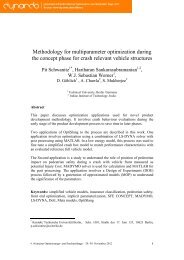multiPlas - Dynardo GmbH
multiPlas - Dynardo GmbH
multiPlas - Dynardo GmbH
Create successful ePaper yourself
Turn your PDF publications into a flip-book with our unique Google optimized e-Paper software.
Fig. 3-12 stress-strain relation in <strong>multiPlas</strong> (mlaw=0,2; mlaw = 1)<br />
3.3.6.2 Nonlinear deformation behaviour during tensile load<br />
Concrete tends to soften relatively brittle with local appearances of cracks. For including this into the<br />
context of a continuum model, a homogenized crack and softening model is needed. The crack itself does<br />
not appear in the topology description of the structure - but is described by its impact on stress and<br />
deformation state [6-16],[6-21].<br />
The softening process is formulated respectively to the energy dissipation caused by the occurance of<br />
cracks. For the complete cracking, the fracture energy concerning the crack surface has to be<br />
Gf -dissipated.<br />
The used model has its origin within the crack band theory of Bažant / Oh [6-6]. It states that cracks<br />
develop within a local process zone. Its width hPR (crack band width) is a material specific constant.<br />
To avoid a mesh dependency of the softening and to assess the fracture energy correctly, a modification<br />
of the work equation is necessary. For a given width of the crack band and a given fracture energy, the<br />
volume fracture energy can be computed via:<br />
G<br />
f<br />
g f =<br />
h<br />
(3-22)<br />
PR<br />
where:<br />
gf volume fracture energy<br />
Gf fracture energy<br />
hPR crack band width<br />
For meshing of the structure with elements which are larger than the expected width of the crack band the<br />
stress-strain relationship has to be modified in such a way that the volume fracture energy reaches the<br />
following value:<br />
g<br />
σd<br />
Rd<br />
σu<br />
Rd/3<br />
σr<br />
f , INT<br />
hPR<br />
Gf<br />
= gf<br />
=<br />
(3-23)<br />
h h<br />
where: gf,INT<br />
εml εu εr<br />
ε<br />
volume fracture energy at the integration point<br />
h equivalent length<br />
18<br />
USER’S MANUAL, January, 2013






